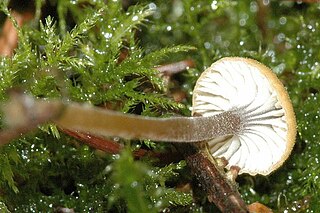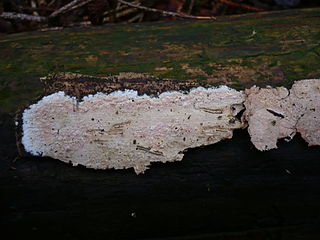
The Clavariaceae are a family of fungi in the order Agaricales. Originally the family contained most of the clavarioid fungi, but in its current sense is more restricted, albeit with a greater diversity of basidiocarp forms. Basidiocarps are variously clavarioid or agaricoid (mushroom-shaped), less commonly corticioid or hydnoid.

The Clavulinaceae are a family of fungi in the order Cantharellales. The family is not well defined, but currently comprises species of clavarioid fungi as well as some corticioid fungi. These species are nutritionally diverse, some being ectomycorrhizal, others wood-rotting saprotrophs, others lichenized, and yet others lichenicolous.

The Agaricomycetes are a class of fungi in the division Basidiomycota. The taxon is roughly identical to that defined for the Homobasidiomycetes by Hibbett & Thorn, with the inclusion of Auriculariales and Sebacinales. It includes not only mushroom-forming fungi, but also most species placed in the deprecated taxa Gasteromycetes and Homobasidiomycetes. Within the subdivision Agaricomycotina, which already excludes the smut and rust fungi, the Agaricomycetes can be further defined by the exclusion of the classes Tremellomycetes and Dacrymycetes, which are generally considered to be jelly fungi. However, a few former "jelly fungi", such as Auricularia, are classified in the Agaricomycetes. According to a 2008 estimate, Agaricomycetes include 17 orders, 100 families, 1147 genera, and about 21000 species. Modern molecular phylogenetic analyses have been since used to help define several new orders in the Agaricomycetes: Amylocorticiales, Jaapiales, Stereopsidales, and Lepidostromatales.

Contumyces is a genus of brightly colored possibly bryophilous or graminicolous agarics in the Hymenochaetales. They have an omphalinoid morphology, and therefore were previously classified in Omphalina. They inhabit mossy or grassy silty or sandy soils in the Northern Hemisphere. Phylogenetically related agarics are in the genera Rickenella, Gyroflexus, Loreleia, Cantharellopsis and Blasiphalia, as well as the stipitate-stereoid genera Muscinupta and Cotylidia and clavarioid genus, Alloclavaria. Contumyces is most similar to Rickenella and Blasiphalia and differs by having its cystidia on the cap, stipe, and hymenium in clusters, whereas in Rickenella and Blasiphalia the cystidia are solitary.

Rickenella is a genus of brightly colored bryophilous agarics in the Hymenochaetales that have an omphalinoid morphology. They inhabit mosses on mossy soils, peats, tree trunks and logs in temperate regions of both the Northern and Southern Hemispheres. Phylogenetically related agarics are in the genera Contumyces, Gyroflexus, Loreleia, Cantharellopsis and Blasiphalia, as well as the stipitate-stereoid genera Muscinupta and Cotylidia. and the clavarioid genus, Alloclavaria.
Blasiphalia is a fungal genus in the family Repetobasidiaceae. A monotypic genus, it contains the honey colored omphalinoid agaric, Blasiphalia pseudogrisella, which grows with the liverwort genus Blasia. Phylogenetically related agarics are in the genera Rickenella, Gyroflexus, Loreleia, Cantharellopsis and Contumyces, as well as the stipitate-stereoid genera Muscinupta and Cotylidia and clavarioid genus, Alloclavaria. Blasiphalia is most similar to Rickenella and Contumyces, and was only just recognized as a distinct genus in 2007 based upon molecular analysis. The fungus is unique in parasitizing Blasia by forming clasping appresoria on its host's rhizoids. Its basidiospores also germinate on the host's gemmae and clasp them and therefore can be disseminated together with the gemmae.

Gyroflexus is a monotypic genus with a yellowish-ivory colored omphalinoid agaric in the Hymenochaetales that grows on living Sphagnum Phylogenetically related agarics are in the genera Rickenella, Blasiphalia, Loreleia, Cantharellopsis and Contumyces, as well as the stipitate-stereoid genera Muscinupta and Cotylidia and clavaroid genus, Alloclavaria. Gyroflexus brevibasidiatus, the type, amongst the vaguely omphalinoid genera is distinguished by its small, mammiform pileus, growth on Sphagnum, and lack of cystidia.

Loreleia is a genus of brightly colored agarics in the Hymenochaetales that have an omphalinoid morphology. They inhabit mosses and or liverworts on soil in temperate regions of the Northern Hemisphere. Phylogenetically related agarics are in the genera Contumyces, Gyroflexus, Rickenella, Cantharellopsis and Blasiphalia, as well as the stipitate-stereoid genera Muscinupta and Cotylidia and the clavaroid genus, Alloclavaria. However, the large number of DNA base-pair changes causes a long-branch to form in phylogenetic analyses depicted as cladograms.
Cantharellopsis is a tan- to whitish-colored bryophilous monotypic genus in the Hymenochaetales. The fruit bodies of the single species Cantharellopsis prescotii has a form intermediate between an Omphalina and a chanterelle (Cantharellus) because of its forked, fold-like gills. It inhabits moss on calcareous soils in temperate regions of Europe. Phylogenetically related agarics are in the genera Contumyces, Gyroflexus, Loreleia, Rickenella and Blasiphalia, as well as the stipitate-stereoid genera Muscinupta and Cotylidia and the clavarioid genus, Alloclavaria.

Cotylidia is a fungal genus characterized by small to moderately sized, white to palely yet brightly colored, stalked, fan-shaped to funnel-shaped fruit bodies with a smooth to wrinkled hymenium, tissues composed of monomitic hyphae, basidia producing smooth, nonamyloid spores, the absence of clamp connections, and bearing projecting cylindrical, thin-walled, hymenial cystidia. The genus is classified in the Hymenochaetales, however the type species, C. undulata has not yet been sequenced. Phylogenetically-related agaricoid fungi to the two species of Cotylidia thus far sequenced are in the genera Rickenella, Contumyces, Gyroflexus, Loreleia, Cantharellopsis and Blasiphalia, and Muscinupta and the clavarioid genus, Alloclavaria.

Alloclavaria is a clavarioid genus in the Hymenochaetales recently segregated from Clavaria by molecular analysis. Phylogenetically related fungi are in the agaricoid genera Rickenella, Contumyces, Gyroflexus, Loreleia, Cantharellopsis and Blasiphalia, as well as the stipitate stereoid genera Cotylidia and Muscinupta. The only species as yet placed in Alloclavaria is the type, formerly known as Clavaria purpurea under which name it is often cited or illustrated.. It is suspected, via circumstantial evidence, i.e. habitat, but not proven, that Alloclavaria is mycorrhizal.

The Hymenochaetaceae are a family of fungi in the order Hymenochaetales. The family contains several species that are implicated in many diseases of broad-leaved and coniferous trees, causing heart rot, canker and root diseases, and also esca disease of grapevines. According to a standard reference text, the family contains 27 genera and 487 species.

Trichaptum is a genus of poroid fungi. The genus was circumscribed by American mycologist William Alphonso Murrill in 1904. Formerly classified in the family Polyporaceae, several molecular studies have shown that the genus belongs to the order Hymenochaetales.

Phlebiopsis is a genus of poroid crust fungi in the family Phanerochaetaceae. The genus contains 11 species, which collectively have a widespread distribution. The genome sequence of the type species, Phlebiopsis gigantea, was published in 2014.

Amylocorticiales is an order of fungi in the class Agaricomycetes. The order was circumscribed in 2010 to contain mostly resupinate (crust-like) forms that have been referred to genera Anomoporia, Amyloathelia, Amylocorticiellum, Amylocorticium, Amyloxenasma, Anomoloma, Athelopsis, Ceraceomyces, Hypochniciellum, Leptosporomyces and Serpulomyces and the anomalous species, Athelia rolfsii, now classified in its own genus, Agroathelia.
Lawrynomyces is a genus of fungi in the Rickenella-clade of the order Hymenochaetales, containing the single species Lawrynomyces capitatus.
Tropicoporus tropicalis is part of the family Hymenochaetaceae, and was recently renamed to Tropicoporus tropicalis from Inonotus tropicalis, which is part of the Inonotus clade B. Tropicoporus tropicalis is a wood-decaying basidiomycetes that rarely causes disease in animals and human, and is commonly found in humid climate such as Brazil. In its natural environment, the fungus is associated with white rot woody angiosperms, and has its annual fruiting body on tree trunks and branches. Tropicoporus tropicalis has two kinds of hyphae, generative and skeletal, that lack clamp connections.

Inocutis is a genus of nine species of polypore fungi in the family Hymenochaetaceae.
Kurt Egon Hjortstam (1933–2009) was a Swedish mycologist, specialising in the taxonomy of corticioid fungi.



















